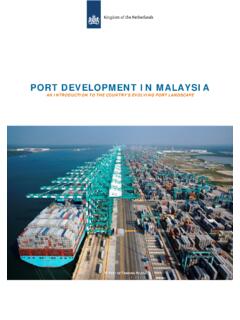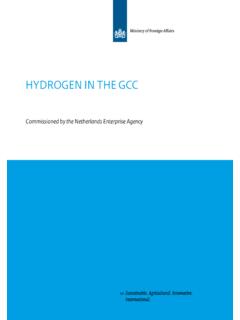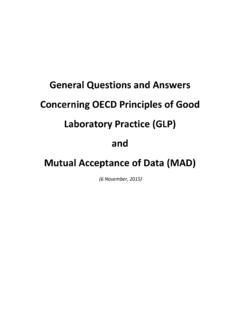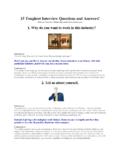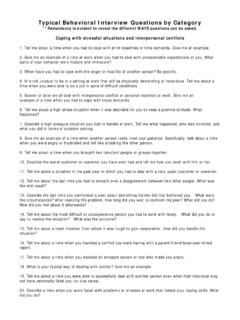Transcription of Frequently asked questions and answers concerning ... - RVO.nl
1 July 2016 1 Frequently asked questions and answers concerning the EED energy audit (Article 8) In 2012, the European Energy Efficiency Directive (2012/27/EU), also known as the EED, was established. The aim of this Directive is to help to realise the European target set in 2007 to reduce European energy consumption by 20% by 2020. This should contribute to a reduction in greenhouse gas and air pollutants, to a decrease of energy costs, and to lower dependence on import of fossil fuel. This Directive contains commitments of Member States as well as companies that have been implemented in national laws and regulations. One of these concerns the obligation for larger companies to carry out an energy audit, which is implemented in the provisional regulation of implementation Articles 8 and 14 Energy Efficiency Directive (in Dutch: Tijdelijke regeling implementatie artikelen 8 en 14 Richtlijn energie-effici ntie) This document containing Frequently asked questions and their answers is meant to facilitate the execution of Article 8 of this Directive.
2 It will help enterprises, enforcers, and advisors to interpret the Directive. The document will be regularly updated according to experiences and new developments. Previous versions of this document have been agreed upon by representatives of businesses, enforcers and advisors (the Netherlands Enterprise Agency). No legal rights can be derived from this document. Enterprises and competent authorities take full responsibility for decisions taken. Index 1. What is the objective of an energy audit? 2. Target group of the energy audit: a) Who is responsible for conducting an energy audit? b) Does an audit need to be carried out if an enterprise is part of an international concern with over 250 employees in total, or with a total revenue > 50 million a year as well as an annual balance total > 43 million? c) How is the audit obligation dealt with for concerns or enterprises consisting of more than one entity? d) Which exemptions are applicable? e) Which alternative energy or environmental management systems constitute an exemption?
3 F) Who is responsible for the energy audit when a building is let? g) What happens when an enterprise exceeds the financial or personal criteria during the course of the year? h) What is the relationship between the EED energy-audit and the approved energy-saving measures ( Erkende Maatregelenlijsten )? i) Are educational institutes obliged to carry out an energy audit? j) Should franchise owners be taken into account when determining the size of an enterprise? 3. What are the criteria for an energy audit? a) Which criteria are applicable? b) What does the enterprise need to provide? c) How should transport be taken into account? d) What are possible cost-efficient energy saving measures? July 2016 2 4. Monitoring, enforcement and deadlines a) Who is authorised to conduct an audit? b) When does the audit need to be done? c) How are audits verified? d) What are the sanctions? e) How is confidential business information dealt with? f) Which rules take precedence where multiple entities and competent authorities are involved?
4 Appendix: Step by step guidance and flow diagram to determine the EED energy audit obligation 1. What is the objective of an energy audit? - The energy audit is a systematic procedure taking place every four years. It aims to collect sufficient information concerning the enterprise's current profile on energy consumption in order to identify possible cost efficient energy saving options, but also to qualify and report on its results. - The Directive intends to increase awareness and insight into possible savings opportunities with the energy audits. 2. Target group of the energy audit a) Who is responsible for conducting an energy audit? - The energy audit applies to large enterprises. These are enterprises that are not covered by the SME-category as described in the Directive. Large enterprises are enterprises with over 250 employees, or with a total revenue of more than 50 million a year and an annual balance total of more than 43 million. - See the step by step guidance in the appendix to confirm if these conditions are met.
5 B) Does an audit need to be carried out if an enterprise is part of an international concern with over 250 employees in total, or with a total revenue > 50 million a year as well as an annual balance total > 43 million? - An audit only needs to be conducted where the Dutch entities fall within the large enterprise definition ( > 250 employees etc.) c) How is the audit obligation dealt with for concerns or enterprises consisting of more than one entity? - If one of the entities has over 250 employees (or a total revenue of > 50 million a year and an annual balance total of > 43 million), all (Dutch) entities of that concern are required to audit. The audit is also required, if none of the entities on their own meet the criteria, but together they will. d) Which exemptions are applicable? Long term agreements - In 2012, companies that participate in the long term agreements LTA3 and LEE (in Dutch: MJA3 and MEE) have handed in a new plan for energy efficiency for the period of 2013-2016.
6 Because of this, these enterprises have already met the requirement to carry out an energy audit before December 5, 2015. Energy and environmental management systems - Article 3 of the Directive states that a business is exempted of the obligation to carry out an energy audit, if the applied energy management system is certified according to European and international standards, and includes an energy audit that meets the minimum criteria, as referred to in appendix VI of the Directive. For example, this applies to the ISO 50001 system for energy management. The ISO 14001 system for environmental management only pays limited attention to energy, which makes an additional module such as the ISO 14051 necessary for an exemption. Other (future) certified systems may be eligible for exemption concerning the energy audit obligation audit. This, however, is up to the competent authorities to judge. - See also question and answer and July 2016 3 e) Which alternative energy or environmental management systems constitute an exemption?
7 A number of energy and environmental management systems address energy audits whereby these constitute a full or partial alternative for the EED energy-audit. Whether this is the case and to what extent these alternatives apply is up to the discretion of the competent authority. To support the use of environmental systems in relation to the EED energy-audit obligation, a number of factsheets have been developed (in Dutch). These can be found on: ( > energie-audit > alternatieve invulling met keurmerk). These factsheets specify to what extent the system meets the requirements of the EED energy-audit obligation, including guidelines for the competent authority. All the systems under consideration pay attention to energy audits. Administrators of other systems certified by an independent body including an energy audit component, which largely corresponds to the requirements of the EED Directive, can contact The system will then be evaluated. f) Who is responsible for the energy audit when a building is let?
8 If a building constitutes an important part of the enterprise's business, it must be included in the energy audit. Energy-saving measures in buildings can be taken both by the owner (technical installation / insulation) and the tenant (behavioural measures, equipment). Obviously, an enterprise can take more measures if it also owns the property. Where an enterprise rents the building the energy audit will mainly relate to the matters to which the enterprise does have influence. g) What happens when an enterprise exceeds the financial or personal criteria during the course of the year? If an enterprise exceeds the headcount or financial criteria, this does not immediately affect the status (SME / non-SME). The enterprise retains the status of the beginning of the year, and will lose the status if it exceeds the criteria over two consecutive financial years. h) What is the relationship between the EED energy-audit and the approved energy-saving measures ( Erkende Maatregelenlijsten )?
9 If an enterprise is using the approach based on approved energy-saving measures ( Erkende Maatregelenlijsten ) the competent authority can provide a (partial) exemption to the audit obligation. Where an enterprise is regulated by Article of the Activities decision, Environmental Management Act (the so-called category A and B companies), the enterprise can choose to follow the approved measures approach by carrying out measures from the approved measures list for its specific industrial (sub)sector. In the EED energy-audit report enterprises must include the following: 1. The drafting of an energy balance of the annual energy use and a schematic overview of all existing energy flows (including transport). 2. An overview of all relevant approved measures (where the relevance should be determined on the basis of the reference situation, and the technical and economic conditions that are mentioned in the approved measures list). 3. An overview of possible cost-effective energy-saving measures in the field of transport management.
10 If the enterprise (at entity level, local) uses <200,000 kWh electricity and <75,000 m3 natural gas annually, it is sufficient to report the annual energy use instead of (1). There are currently (July 2016) approved measures lists published for the following sectors: metal, plastics & rubber, automotive repair sector, datacentres, offices, healthcare, education, agriculture, sports & recreation, automotive, hotels & restaurants, parts of the food industry (fruits & vegetables processing industry, soft drinks, water & juices producers, baking & confectionary industry). A list for the retail sector is expected to be available in short term. More information on the approved measures approach can be found on i) Are educational institutions obliged to carry out an energy audit? In the step by step guidance the question in step 2 refers to the conducting of economic activities. Formal, regular education is not an economic activity. However, for example, with courses or company training educational institutes can be in competition with other providers of commercial training.


